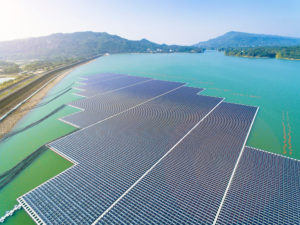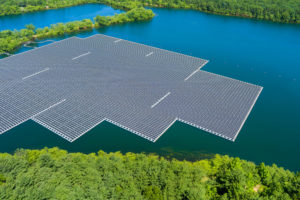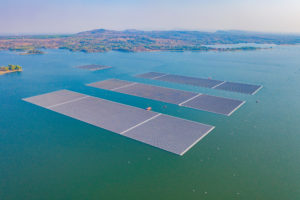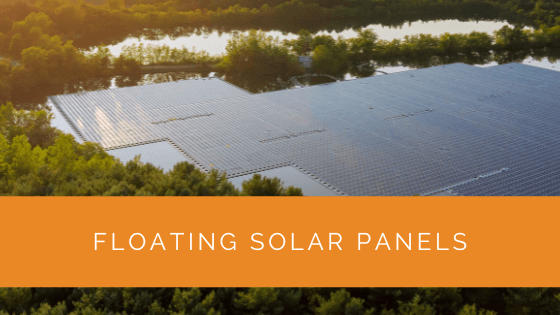Floating solar plants offer an environmentally friendly approach to harnessing energy by combining the power of water and the sun. This innovative technology enables electricity generation through solar panels, then transmitted via an underwater wiring system to transmission plants.
The cost-effectiveness of solar power has positioned it as one of the most economical methods of electricity production. However, the challenge lies in finding sufficient space for these solar installations. Despite the unconventional pairing of energy and water, floating photovoltaic (PV) systems have been deployed in various locations worldwide, making them a compelling solution for sustainable energy generation. This article will delve into the fascinating world of floating solar panels, providing you with insights and information to better understand this innovative technology.
Contents
- 1 Key Takeaways
- 2 What is a Floating Solar?
- 3 How Do Floating Solar Panels Work?
- 4 Should You Install Floating Solar Photovoltaic?
- 4.1 Advantages of Floating Solar Power
- 4.1.1 Floating Solar Power Projects Are More Efficient
- 4.1.2 Floating Solar Power Projects Save Valuable Land Resources
- 4.1.3 These Renewable Energy Plants Have a Good Environmental Impact
- 4.1.4 Floating Solar Plants Require Minimal Maintenance
- 4.1.5 Floating Arrays Help Reduce Evaporation from Water Bodies
- 4.2 Disadvantages of FPV projects
- 4.1 Advantages of Floating Solar Power
- 5 How Much Is It Going to Cost?
- 6 What Does the Future Hold for Floating Arrays?
- 7 Case Study: Installation of Floating Solar Panels on a Reservoir
- 8 Expert Insights From Our Solar Panel Installers About Floating Solar Panels
- 9 Discover the Power of Solar with Solar Panels Network
- 10 Final Thoughts
Key Takeaways
- Floating solar panels, known as floating photovoltaic (FPV) systems, are a sustainable and efficient way to generate electricity by placing solar panels on water bodies like lakes, ponds, and reservoirs.
- Floating solar panels offer several advantages, including increased efficiency due to cooling effects from water, saving valuable land resources, having a positive environmental impact by reducing evaporation, and requiring minimal maintenance.
- However, challenges include higher installation costs, potential disruptions to aquatic life, and site-specific issues related to anchoring and mooring systems. The future of floating arrays looks promising as technology advances and the renewables industry grows.
What is a Floating Solar?
Floating solar, technically called floating photovoltaic (FPV) or photovoltaics, is a kind of solar arrangement that floats on the surface of any water body. Solar panels must be attached to a buoyant framework that keeps them afloat above the water’s surface.
Most solar installations are located on calmer water surfaces like lakes and ponds, not oceans and rivers. Man-made water bodies like reservoirs are also among the popular choices.
The solar module, vertical and horizontal frames, anti-rust material, buoyancy body, inspection footrest, and module mount assembly comprise a floating solar panel plant.
The solar module must be dustproof, humidity-resistant, lead-free, and effectively protected to prevent water damage. Polyethylene buoyancy is used in this technique, which can hold 2.5 times its weight. The floating structure comprises a magnesium alloy covering that prevents it from getting corrupted. Although it is a relatively new concept, it has started to gain popularity in the UK.

Now, let’s learn how the floating solar panels work.
How Do Floating Solar Panels Work?
The floating solar power plants’ work begins with collecting solar energy from highly efficient solar power panels. The power generated by the solar panels is then integrated into the combined box before being transmitted to the central inverter. The inverter converts DC to AC for transfer, much like a standard PV system. The power from the inverter is initially transmitted to the transformer, where it is stepped down and then sent to the transmission system, from where it is sent to the end-user.
Deploying floating solar power panels in water bodies is a win-win situation. The panels cool themselves to prevent excessive heat from entering the water bodies, increasing their energy generation. The cooling effect can potentially boost the annual energy output of floating solar panels by 6%. So cool (literally).
When you think about it, the efficiency of floating solar power panels and their overall working principle is a wonderful idea that answers many problems.
Should You Install Floating Solar Photovoltaic?
Here are some advantages of installing floating solar power plants over traditional ground projects.
Advantages of Floating Solar Power
Floating Solar Power Projects Are More Efficient
Solar panels are durable and can withstand extreme temperature fluctuations. However, higher temperatures result in lower power outputs as with other technologies. The efficacy of solar panels degrades as temperatures rise, which can be an issue for property owners who want to install panels in a hot, sunny region. The water bodies that host the floating solar plants help cool down the solar equipment, allowing the panels to produce power more efficiently in hot areas than they would otherwise.
Floating Solar Power Projects Save Valuable Land Resources
Floating solar plants do not take up a limited spare land area. As solar is land-intensive, floating solar is an excellent alternative. Many of these structures can be found on water bodies like hydroelectric dams, wastewater treatment reservoirs, and drinking water reservoirs, where vacant space exists. This allows landowners to use a location that might otherwise go unused. Rather than deploying on sunny land that could be used for something else in the future, floating solar projects are a great option.
Furthermore, developing floating solar projects on open water eliminates the need for tree cutting and destruction of forests, which is a standard procedure with larger solar panel installations.
These Renewable Energy Plants Have a Good Environmental Impact
Floating solar panels can undoubtedly aid in the promotion of healthier surroundings. Water has a cooling effect on solar equipment in floating solar panels, but it also has a cooling effect on the solar equipment. The ponds, reservoirs, and lakes are shaded by floating structures, lowering evaporation. This is especially beneficial in drought-prone locations, where water loss due to evaporation can increase over time and lead to a shortage.
Finally, floating solar panels provide a clean, renewable energy source. Renewable energy sources help reduce carbon emissions and other toxins in the atmosphere, influencing the natural environment and human health. This positive environmental impact also creates a vast potential for this technology in the market. Other than the UK, many Asian nations such as China and Japan have also promoted their use because of the promising growing industry and a clean energy future.
Floating Solar Plants Require Minimal Maintenance
Floating structures require minimal operation and maintenance due to the aforementioned cooling effect. Of course, the type of installation will determine this. Algae blooms are a severe menace to water bodies. One of its reasons is greater light filtration, which FPV projects mitigate.
Floating Arrays Help Reduce Evaporation from Water Bodies
Floatovoltaics have a lot of potential to reduce the rapid evaporation occurring in water bodies due to rising temperatures. Research has shown that floating solar plants can prevent 9000+ acre-feet of water from evaporating regularly.

Disadvantages of FPV projects
Following are some demerits that you get if you install a floating solar plant over a traditional ground project.
Floating PV May Not Be Right for Everyone
Floating solar panels are not suitable for everyone. Most floating solar arrays are large-scale, supplying energy to utility companies, huge towns, businesses, and municipalities. If you’re considering going solar for your home, a rooftop or traditional ground-mounted system makes more sense.
Those considering investing in floating solar panels must have access to a vast water surface, large enough to accommodate hundreds and thousands of solar panels. In contrast to these installations, the average household solar panel system includes only about 20 panels.
Floating Energy Systems Can Be Heavy on Your Pocket
Floating solar panels may have higher installation costs than standard solar panels. Since this recent development needs specialised equipment and more specific installation knowledge, it is often more expensive than establishing comparable-sized solar farms on rooftops or ground-mounted solar projects. However, as with standard solar panels, the cost of installing floating solar plants is expected to decrease as the technology of the floating solar market progresses.
Floating Solar Power Plants can Be Dangerous to Aquatic Life
While the evidence is still inconclusive, solar panels can potentially disrupt aquatic life by preventing the sunlight from reaching its maximum water surface. Furthermore, the panels and apparatus that lock them can endanger animals unaware of their existence or take up space in their natural environment.
Floating PV systems’ most significant negative element is the possible environmental impact on fish and other water-dwelling species. However, when floating solar panels are constructed on man-made lakes and reservoirs, the biological diversity is less than that of a natural lake, making them desirable for floating solar panel systems. Ergo, a site conditions assessment should be taken to understand the site-specific environmental conditions before executing the project.
Anchoring and Mooring Issues Can Pose Barriers to Installation
Any reservoir/site has its own set of obstacles. Anchoring and mooring are very site-specific activities.
Anchors cannot be installed on the seabed in some reservoirs, and others have substantially irregular seabed profiles and poor bathymetric studies. In dams with considerable water level variations, mooring and anchoring become difficult.
How Much Is It Going to Cost?
Overall, the costs of constructing an FPV system from project to project and from location to location vary. Water level change, depth, quality, and salinity are all factors that influence the cost structure.
The bathymetry of the reservoir determines the anchoring and mooring system’s design arrangement. Depending on the prevailing wind regime in the area, the FPV plant design must withstand site-specific environmental issues.
Other elements to consider are the distance from the shore, accessibility to the site, proximity to the grid, local infrastructure, and overall logistics. Furthermore, water-based electrical technology increases operation and maintenance expenses and may necessitate better moisture resistance in installed cabling. In addition, due to a lack of empirical evidence, projects often necessitate a more thorough technical due diligence.

What Does the Future Hold for Floating Arrays?
We can only expect a greater reliance on renewables in the future. Thanks to technological advancements, these have gotten much cheaper and more effective even in the last decade. The popularity of this holistic system-level approach has accelerated considerably in the past few years.
The UK is undoubtedly the one to follow for renewable energy breakthroughs, with ambitious targets to achieve carbon neutrality as soon as possible.
Looking ahead, fast-growing technology such as AI, cloud, and IoT will undoubtedly enable even more optimisation, presenting exciting potential for carbon reduction.
Case Study: Installation of Floating Solar Panels on a Reservoir
Background
At Solar Panels Network, we are committed to pushing the boundaries of renewable energy solutions. This case study details the installation of a floating solar panel system on a large reservoir, aimed at generating sustainable energy while conserving land and water resources.
Project Overview
The project was designed to implement a floating photovoltaic (FPV) system on a reservoir used primarily for irrigation. The objectives included generating electricity efficiently, reducing water evaporation, and providing an environmentally friendly energy source without occupying valuable land.
Implementation
- Site Assessment and Design: Conducted a thorough assessment of the reservoir, considering factors such as water depth, surface area, and potential environmental impacts. The design phase involved selecting durable materials for the buoyant framework and ensuring that the solar modules were protected against humidity and corrosion.
- Installation Process:
- Construction of Floating Platforms: Assembled the floating structures with high-density polyethylene for buoyancy and magnesium alloy coatings for corrosion resistance.
- Solar Panel Installation: Mounted solar panels on the platforms, ensuring optimal alignment for maximum sunlight absorption.
- Electrical Integration: Connected the panels to a central inverter system, which converts the generated DC power to AC. This setup was integrated with the local grid infrastructure, facilitating efficient energy transmission.
Results
- Energy Efficiency: The floating solar panels demonstrated enhanced efficiency due to the cooling effect of water, resulting in a 6% increase in annual energy output compared to land-based systems.
- Environmental Impact: The project reduced water evaporation by shading the water surface, which is particularly beneficial in drought-prone areas. Additionally, the system had minimal impact on aquatic life due to careful site selection and design.
- Economic Viability: While the initial costs were higher than traditional ground-mounted systems, the project benefited from lower maintenance costs and increased efficiency, providing a solid return on investment over time.
Summary
The installation of floating solar panels on the reservoir proved to be a successful and sustainable solution, combining efficient energy generation with environmental benefits. This project highlights the potential of FPV systems to overcome land constraints and enhance renewable energy production. The positive results underscore the viability of floating solar technology as a critical component in the transition to sustainable energy sources. As we continue to explore innovative energy solutions, projects like this are essential for achieving a cleaner and more sustainable future.
Expert Insights From Our Solar Panel Installers About Floating Solar Panels
Floating solar panels are an innovative solution to land constraints, providing an efficient way to harness solar energy on water bodies without competing for valuable land resources.
Senior Solar Installation Engineer
The cooling effect of water significantly enhances the efficiency of floating solar panels, making them a superior choice in regions with high temperatures.
Chief Renewable Energy Technician
While the initial costs can be higher, the long-term benefits of floating solar systems, such as reduced evaporation and minimal maintenance, make them a worthwhile investment.
Environmental Impact Specialist
Discover the Power of Solar with Solar Panels Network
Are you navigating the world of solar installations? Look no further than Solar Panels Network, the UK’s trusted partner in harnessing the sun’s potential. Our dedication goes beyond just installations; we’re on a mission to transform how homeowners and businesses across the UK perceive and utilise energy. By choosing us, you’re reducing your carbon footprint and making a smart financial move that promises savings for years ahead. Contact us today and embark on your solar journey.
Final Thoughts
Floating PV is still a new approach to the energy transition compared to the ground panels we use. Still, it offers a huge potential in regions with limited space for solar farms or abundant water. We will become less dependent on fossil fuels as we put more solar on the land, rooftops, and oceans.
For now, floating PV has a promising future in boosting worldwide renewable energy generation in various regions and sectors. As tech and construction techniques advance and via economies of scale, installation prices will decrease. Meanwhile, the benefits, which range from encouraging sustainable energy to reducing water scarcity and preserving biodiversity to creating jobs, are only getting started.
About the Author
Solar Panels Network stands at the forefront of solar energy solutions, driven by a team of seasoned solar engineers and energy consultants. With over decades of experience in delivering high-quality solar installations and maintenance, we are committed to promoting sustainable energy through customer-centric, tailored solutions. Our articles reflect this commitment, crafted collaboratively by experts to provide accurate, up-to-date insights into solar technology, ensuring our readers are well-informed and empowered in their solar energy decisions.

